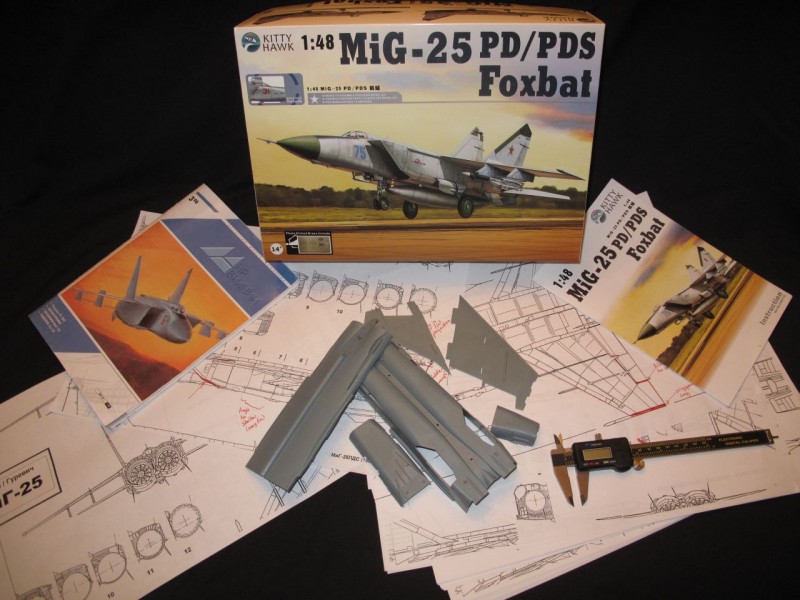1⁄48Kitty Hawk MiG-25PD Feature Review
Introduction
Few aircraft typify the Cold War, and particularly the Soviet side of the Cold War, better than the MiG-25. It’s brutish design, and single-purpose intent makes it perhaps one of the most iconic aircraft designs of the post-World War II (or should I say post Great Patriotic War) era. Born at the height of the Cold War and used for the duration (and even into today) the MiG-25 is one of those subjects long neglected by the modeling industry. Fortunately Kitty Hawk has come to the rescue in grand fashion. It’s not a kit without faults though – let’s take a deeper look at this new kit of the iconic Soviet beast.
MiG-25 History
The Ye-155 (Ye, the transliteration for the Cyrillic “E,” pronounced “yeh,” stands for yedinitsa or unit – a designation used in the Mikoyan bureau to designate “one-offs”) was born as a response to the escalating speed of designs in the west. With types like the Convair B-58 and Lockheed A-12 entering service, as well as the North American XB-70 in testing, the Soviet PVO, or air defense command, was in search of an interceptor capable of extreme speed (mach 3), a high service ceiling (20,000+ meters) and long range. Range had been a severely limiting factor of previous interceptors in PVO service. At the same time the VVS (Frontal Aviation – basically the Soviet Air Force) was in search of a reconnaissance platform with very similar characteristics. As a result a joint service design was to fill both roles, and in February 1961 the Communist Party of the Soviet Union issued a directive to the Mikoyan OKB with the development of the Ye-155 prototype.From this the Ye-155P (perekhavatchik – or interceptor) and Ye-155R (razvedchik – or reconnaissance) families were born. And as a result, four distinctly different groups of MiG-25s were developed: the MiG-25P interceptor and MiG-25PU/RU trainers (from the Ye-155P), MiG-25R reconnaissance and MiG-25B anti-radar (from the Ye-155R). As this kit is the interceptor release from Kitty Hawk – we will concentrate on the interceptors for purpose of this review. As the other variants are released, we will delve deeper into the history of those types.
So much can be written about the history and development of this fascinating type. The MiG-25 caused quite a sensation in the West, and a lot of fretting from some analysts – especially for a service (the PVO) that had previously not provided much concern for Western planners. The MiG-25, in many ways kicked off a new round in the arms race, and contributed directly to the start of the US TFX program that resulted in the McDonnell-Douglas F-15 Eagle. Alas, there are many good articles and books available on the topic should you wish to learn more about the development behind the MiG-25.
The main production of the initial MiG-25P began in 1971 at the Gorky factory. Serving around the Soviet Union it was the scourge of the skies and the subject of intense analysis by western observers. The large wings pointed to high maneuverability which was not expected out of designs of the day. It was not until 1976 when Lt. Victor Belenko defected to the west in a MiG-25P, landing at Hakodate airport in northern Japan. Western analysts were afforded a firsthand opportunity to evaluate the MiG-25 and found that the type was not what was expected.
Resulting from this event a commission was formed in the Soviet Union, and based on the results of this commission, it was decided that unless the MiG-25s weapons control systems were drastically upgraded, the type’s combat effectiveness would be negated. This resulted in the MiG-25PD. Now fitted with the Sapfir-25 radar and a host of additional changes, this new type served as the basis for the Soviet interceptor force until the type’s retirement following the introduction of the newer Su-27 and MiG-31. The upgrades made to the newly produced MiG-25PD were viewed as so important a field modification kit was created allowing already serving MiG-25Ps to be upgraded to the PD standard, these were designated MiG-25PDS. We will be publishing a MiG-25 Interceptor variant briefing in the coming days that will delve into the detail differences between the types.












